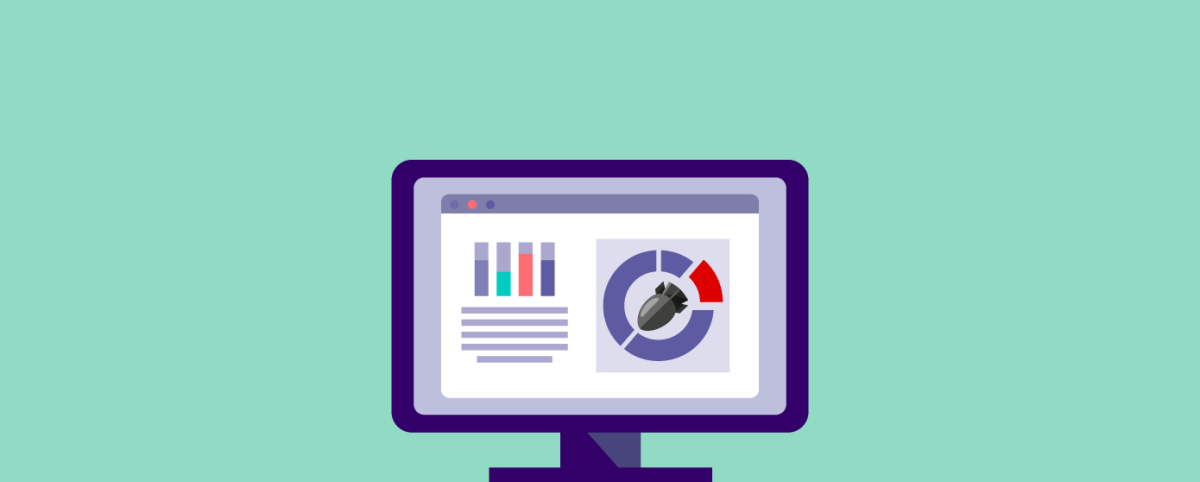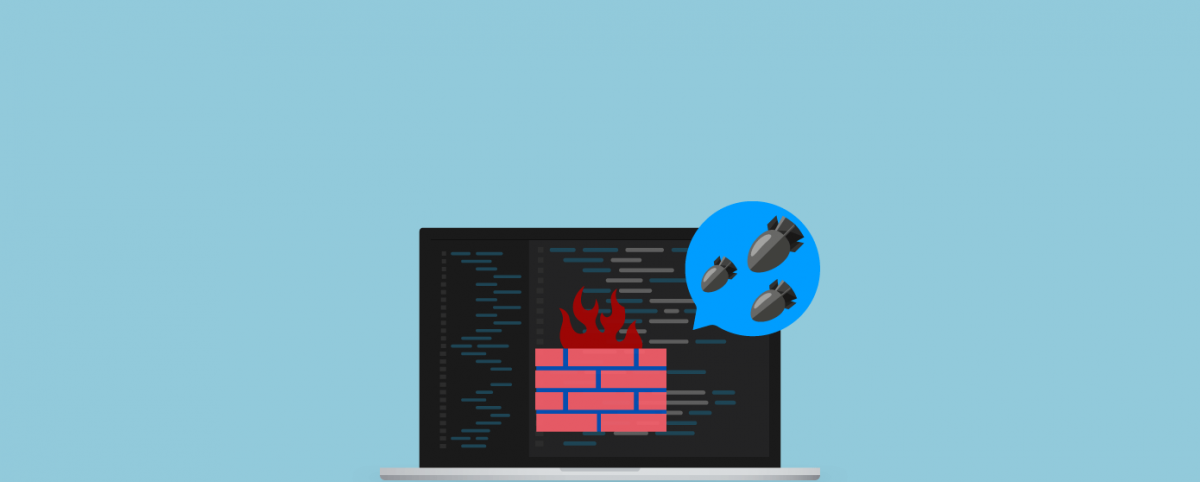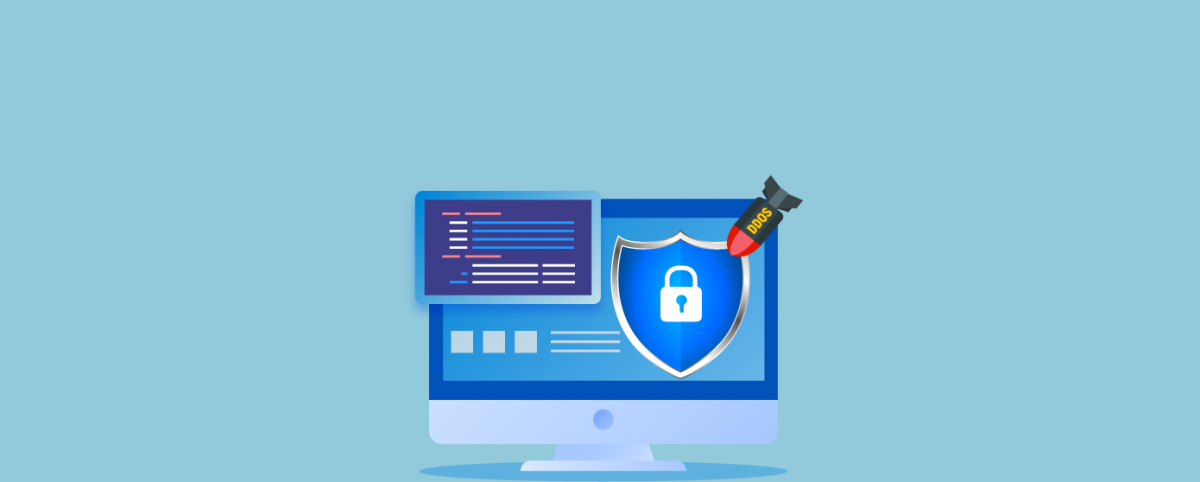Top 10 Cybersecurity Threats WAFs Prevent
A Web Application Firewall (WAF) is your first line of defense against internet traffic that can be both legitimate and malicious. It helps protect your web applications, websites, and servers from various cyber-attacks by filtering out harmful traffic.
WAF (WAAP) is essential for web security as it quickly identifies and addresses vulnerabilities in applications and servers.
It effectively blocks different types of web application attacks, preventing malicious actors from exploiting these weaknesses and giving developers crucial time to fix them.
Discover how WAFs contribute to advanced threat prevention and the key insights you need to stay ahead of cybercriminals.
Top 10 Web Application Threats That WAFs Prevent
1. DDoS Attacks
DDoS attacks seek to overwhelm a target web application/ website/ server with fake traffic, draining network bandwidth, and making it unavailable to legitimate users. DDoS attacks happen in several different ways including flooding, amplification, protocol-based, and reflection.
Some common yet dangerous types of DDoS attacks include SYN flood, DNS amplification, Smurf attacks, Ping of death, HTTP flood, etc.
How a WAF Prevents DDoS Attacks
WAFs provide multiple layers of protection to counter such attacks:
- Traffic Analysis and Anomaly Detection: WAFs monitor incoming requests to detect anomalies, using rate limiting to prevent excessive requests and behavioral analysis to identify suspicious patterns.
- IP Reputation and Threat Intelligence: By leveraging global threat intelligence, WAFs block known malicious IPs, botnets, and proxies. Geofencing further restricts access from high-risk regions.
- Rate Limiting and CAPTCHA Challenges: WAFs prevent DDoS attacks using rate limiting, which restricts excessive requests from abusive sources. However, static rate limiting, which enforces fixed thresholds, may block legitimate users during traffic spikes. To address this, AppTrana’s adaptive rate limiting dynamically adjusts thresholds based on real-time traffic patterns, improving accuracy in detecting and mitigating attacks. Combined with CAPTCHAs and JavaScript validation, this approach effectively differentiates bots from genuine users, ensuring robust DDoS protection.
- Web Scraping and Bot Mitigation: Machine learning (ML) and fingerprinting identify and block bad bots. Bot scoring differentiates between good bots (e.g., search engines), bad bots (e.g., scrapers), and human users to enable selective blocking.
- Layer 7 (Application Layer) Protection: Traditional network-based DDoS defences focus on layers 3 & 4 (e.g., SYN Flood, UDP Flood), but WAFs specifically protect against Layer 7 DDoS attacks such as: HTTP Flood Attacks and Slowloris Attacks.
2. SQL Injection Attacks
In these attacks, the attacker inserts malicious SQL code into user input fields, like submission or contact forms on web applications. This allows them to access the application’s backend database, where they can steal sensitive information, gain unauthorized administrative access, modify or delete data, and potentially take full control of the web application. Learn how to stop SQL injection attacks.
How WAF Prevents SQL Injection Attacks
- Pattern Matching & Signature-Based Detection – WAFs maintain a database of known SQLi attack signatures (e.g., 1′ OR ‘1’=’1, UNION SELECT, DROP TABLE, etc.). Incoming requests are checked against these patterns. If a match is found, the request is blocked.
Example:
SELECT * FROM users WHERE username = 'admin' --' AND password = 'password'
A WAF detects the — comment sequence and blocks the request.
- Input Validation & Sanitization – WAFs enforce strict validation rules on user inputs, rejecting malformed or suspicious queries. They ensure inputs conform to expected formats (e.g., enforcing numeric fields to contain only digits).
- Behavioral & Anomaly Detection – Advanced WAFs use machine learning to identify unusual query patterns. If a request deviates from normal traffic behavior (e.g., excessive use of SQL keywords, nested queries, or automated scripts), it’s flagged and blocked.
- Positive Security Model (Allowlisting) – WAFs can be configured to allow only predefined, expected SQL queries while blocking all others.
Example:
- Allowed query: SELECT name FROM users WHERE id = ?
- Unexpected query: SELECT * FROM users WHERE email LIKE ‘%@%’ (Blocked)
- Escaping & Parameterized Query Enforcement – Some WAFs integrate with backend applications to enforce parameterized queries. This ensures that user input is treated as data, not executable code.
- Virtual Patching – If an application has a known SQLi vulnerability, a WAF can block exploitation attempts even before the developer applies a patch.
Example – AppTrana’s WAF custom rule successfully prevented attack payloads targeting the MOVEit SQL Injection Vulnerability
- Deep Packet Inspection (DPI) & Payload Analysi – WAFs inspect HTTP request bodies, URLs, and headers for SQLi payloads. Even obfuscated payloads (e.g., hex encoding, comments, case changes) can be detected.
3. Cross-Site Scripting (XSS) Attacks
XSS attacks target users of vulnerable web applications or websites to gain control of their browsers. Attackers exploit application vulnerabilities to inject malicious scripts that run when the user loads the site. In reflected XSS attacks, the malicious code executes only if the user clicks a link, while in stored XSS attacks, the code is saved and executed every time the user visits the site.
These attacks compromise personal information, leading to identity theft or session hijacking. They often occur due to unsanitized user input fields or outdated code like VBScript, ActiveX, or JavaScript.
How WAF Prevents XSS Attack
A Web Application Firewall (WAF) blocks Cross-Site Scripting (XSS) attacks by analyzing and filtering malicious scripts embedded in HTTP requests and responses before they reach the client.
- Input Validation & Sanitization – A WAF inspects incoming requests for malicious JavaScript, HTML, or event handlers like onerror= and onclick=. It blocks known XSS payloads, such as <script>alert(‘XSS’)</script>, and ensures that user inputs only contain expected data types.
- Anamoly Scoring – Anomaly scoring analyzes request behavior and assigns risk scores based on deviations from normal patterns. Unlike rule-based detection, it identifies obfuscated or encoded XSS payloads that bypass traditional validation. By assessing context, it detects malicious script injections even in unexpected locations.
AppTrana’s AI-driven anomaly scoring continuously monitors traffic, detects unusual patterns, and adapts to evolving threats. With adaptive learning, it refines risk scoring in real time, blocking high-risk inputs and automated attacks before they execute.
- Signature-Based Detection – Using predefined rules and regular expressions, the WAF detects and blocks known XSS attack patterns, including attempts to inject <script>, javascript:, onmouseover=, and other XSS vectors.
- Context-Aware Filtering – Unlike simple pattern matching, the WAF analyzes where a potential XSS payload appears in a request. For example, <script> might be valid inside an HTML <body> but malicious inside a URL parameter or a form field.
- HTML & JavaScript Encoding – To prevent execution, the WAF automatically escapes special characters like <, >, ‘, and ” in user inputs. This ensures that <script> is converted into <script>, rendering it harmless when displayed in the browser.
- Content Security Policy (CSP) Enforcement – Some WAFs enforce CSP headers to restrict the execution of inline scripts and external JavaScript. For example, a CSP rule like Content-Security-Policy: default-src ‘self’ prevents the loading of JavaScript from untrusted sources.
AppTrana’s Client-Side Protection integrates CSP headers as a key component of client-side security, helping to prevent attacks caused by malicious script injection. By leveraging this protection, you can detect, monitor, and block unauthorized scripts, ensuring robust client-side security.
- Response Filtering (Server-Side XSS Protection) – A WAF can analyze web server responses and strip malicious content before it reaches the user. If a vulnerable application mistakenly reflects <script>alert(1)</script>, the WAF removes or neutralizes it.
Example – AppTrana’s WAF blocked attack payloads exploiting Hotjar’s OAuth+XSS flaw, preventing account takeovers.
4. Zero-day Attacks
Zero-day attacks are those where the organization knows about the existence of vulnerabilities in the hardware/ software only when the attack happens. These are unexpected and therefore, extremely damaging for businesses as they do not have quick fixes or patches to protect their application. The cyber-attackers, on the other hand, may have been snooping around the application way before and exploited the vulnerabilities as soon they found them.
How WAF Prevents Zero-day Attacks?
- Anomaly-Based Detection (AI & ML) – Since zero-day exploits don’t match known signatures, AI-driven WAFs analyze traffic patterns and detect suspicious behavior. They flag unusual requests, such as unexpected payloads or encoding patterns, and block them before they reach the application.
- Virtual Patching for Immediate Protection– When a new zero-day vulnerability is discovered, a Managed WAF includes a dedicated security team that applies virtual patches to block attacks before an official vendor fix is released. This prevents exploitation in real time and ensures continuous security.
- Threat Intelligence & Automated Updates – Managed WAFs receive continuous updates from global threat intelligence sources. By analyzing new attack patterns, they dynamically adjust security rules to prevent emerging threats, such as remote code execution (RCE) exploits.
- Positive Security Model (Whitelist Approach) – A WAF enforces strict input validation, allowing only expected inputs while rejecting anything suspicious. This approach prevents zero-day exploits like XSS injections by blocking unrecognized scripts and payloads.
Explore how AppTrana WAF’s risk-based protection delivers real-time defense against zero-day threats like Log4j.
5. Business Logic Attacks
Business logic is the critical element connecting and passing information between the UI and databases and software systems, enabling users to effectively use the web application/ website. When there are gaps, errors, or overlaps in the business logic, it creates vulnerabilities that are often exploited by cyber-attackers for monetary and other advantages.
Attackers do not use malformed requests and malicious payloads to orchestrate business logic attacks. They use legitimate values and legal requests to exploit the circumstantial vulnerabilities in the application.
How WAF Prevents Business Logic Attacks
Preventing business logic vulnerabilities requires more than just automated tools. A Web Application Firewall (WAF), like AppTrana’s WAAP, plays a critical role in stopping these attacks by deploying multiple layers of defense:
- Blocking Malicious Inputs: The integrated DAST scanner automatically detects security issues such as SQL injection and Cross-Site Scripting (XSS), allowing the WAF to enforce rules that block malicious inputs before they reach the application.
- Custom Security Policies: Expert penetration testers analyze expected and unexpected behaviors to identify logic vulnerabilities. Based on their findings, the managed security team applies custom policies to mitigate these threats.
- Virtual Patching with SwyftComply: Once vulnerabilities are identified, the WAF can autonomously patch them in real time, preventing attackers from exploiting weaknesses.
- Continuous Monitoring & Threat Intelligence: AppTrana’s WAF provides visibility into attack attempts, attacker behaviors, and evolving threat patterns, helping security teams proactively detect and block business logic attacks.
6. Local File Inclusion (LFI) & Remote File Inclusion (RFI) Attacks
LFI and RFI exploit vulnerabilities in web applications to include and execute unauthorized files on the server. LFI targets local files, potentially exposing sensitive data or allowing code execution, while RFI involves including files from a remote server, which can lead to full server compromise.
How WAF prevents LFI and RFI
- Input Validation & Whitelisting – A WAF enforces strict input validation to prevent attackers from injecting malicious file paths. It ensures only allowed file types and formats are processed by the application, blocking suspicious requests containing ../, file://, or http:// references.
- Blocking Malicious File Requests – A WAF detects RFI payloads by identifying attempts to fetch remote files from external sources. If an attacker tries to include a malicious script using http://malicious-site.com/shell.php, the WAF blocks the request before it reaches the application.
- Virtual Patching & Custom Security Rules – If a web application has an unpatched LFI/RFI vulnerability, a managed WAAP like AppTrana allows the deployment of virtual patches at the WAF level to block exploitation attempts in real time. It applies custom rules to filter out attack patterns before they reach the application.
- Restricting File Execution & Uploads – A WAF prevents unauthorized file uploads and execution by enforcing strict security policies on file directories. It ensures that only legitimate files are executed and prevents attackers from uploading malicious scripts.
Check out how a WAF work here.
7. Remote Code Execution (RCE) Attacks
A remote code execution attack occurs when an attacker can execute arbitrary code on a remote system, usually by exploiting vulnerabilities in a web application. This can lead to unauthorized access, data breaches, or complete control of the affected system.
How WAF Prevents RCE Attacks
- Input Validation & Command Injection Prevention – RCE attacks often exploit unvalidated user inputs to inject malicious commands. A WAF enforces strict input validation to block dangerous payloads, ensuring that only legitimate inputs are processed.
Example: An attacker tries to execute ; rm -rf / through a vulnerable web form. The WAF blocks special characters (;, &, |) commonly used in command injection.
- Anomaly Detection & Behavioral Analysis – AI-driven WAFs use anomaly detection to identify suspicious request patterns associated with RCE attempts. Even if an attack does not match a known signature, the WAF detects and blocks abnormal behaviors.
Example: A hacker sends a request containing encoded payloads like base64_decode(‘malicious_code’). The WAF detects unusual function calls and blocks the request.
- Restricting Untrusted External Requests (RFI Protection) – Attackers may use Remote File Inclusion (RFI) to fetch malicious code from external servers. A WAF blocks such requests by restricting outbound connections to untrusted sources.
Example: AppTrana’s WAF custom rule successfully blocked attack payloads exploiting the CVE-2024-4577 PHP-CGI RCE vulnerability in Windows Servers.
8. Credential Stuffing
Credential stuffing is an automated attack where hackers use stolen username-password pairs to gain unauthorized access to accounts. Since many users reuse passwords, attackers exploit this by testing large sets of leaked credentials on different websites.
How WAF prevents Credential Stuffing
- Bot Detection & Rate Limiting – Credential stuffing relies on bots making rapid login attempts. A WAF identifies and blocks automated traffic by analyzing request patterns.
Example: A single IP sends hundreds of login attempts within seconds. The WAF throttles or blocks the requests to prevent brute-force attempts.
- IP & Device Fingerprinting – Attackers use rotating IPs and device identities to bypass basic security checks. A WAF uses IP reputation databases and fingerprinting techniques to detect suspicious login attempts from unknown or flagged sources.
- Credential Stuffing Pattern Recognition – AI-driven WAFs analyze login attempt patterns to distinguish between legitimate users and credential stuffing bots. If multiple failed logins occur for different usernames from the same source, the WAF flags it as an attack.
- Multi-Factor Authentication (MFA) Enforcement – While a WAF cannot enforce MFA directly, it can redirect suspicious login attempts to MFA verification or challenge pages to prevent unauthorized access.
9. Cross-Site Request Forgery (CSRF)
Cross-Site Request Forgery (CSRF) is an attack where a malicious website tricks users into performing unauthorized actions on a trusted web application where they are already authenticated.
How a WAF Prevents CSRF Attacks
- Enforcing CSRF Tokens Validation – WAFs can block requests that lack proper CSRF tokens, ensuring that only legitimate user actions are processed.
Example: If an attacker tries to submit a fraudulent money transfer request, but the request lacks a valid CSRF token, the WAF blocks it before reaching the server.
- Implementing SameSite Cookie Policies – A WAF enforces secure cookie attributes, such as SameSite=strict, to prevent cookies from being sent with cross-site requests, reducing the risk of CSRF.
- Enforcing Content Security Policy (CSP) & CORS Rules – By enforcing strict CSP and CORS policies, a WAF ensures that only trusted sources can interact with the application, reducing exposure to CSRF attacks.
- Blocking Malicious Referers & Origins – WAFs monitor HTTP Referer and Origin headers to detect and block unauthorized cross-site requests.
10. Server-Side Request Forgery (SSRF)
Server-Side Request Forgery (SSRF) is a web application attack where an attacker manipulates a server into making unauthorized requests on their behalf. This can lead to data exposure, internal network scanning, or even remote code execution. SSRF typically exploits applications that fetch external resources without proper validation, allowing attackers to request internal services, cloud metadata APIs, or restricted endpoints.
How Does a WAF Prevent SSRF?
A Web Application Firewall (WAF) helps mitigate SSRF attacks through:
- Request Filtering – Identifies and blocks requests containing suspicious URLs, IPs, or unexpected protocols.
- URL Whitelisting – Restricts outbound requests to trusted domains, preventing unauthorized internal access.
- Header and Payload Inspection – Detects manipulated request headers and unusual payloads used in SSRF attacks.
- Rate Limiting – Prevents abuse by limiting excessive outbound requests.
- Virtual Patching – Applies real-time security updates to protect against emerging SSRF vulnerabilities.
Securing your web applications with a WAF is no longer optional in today’s threat landscape. It actively shields against attacks such as cross-site scripting, SQL injections, and DDoS, offering peace of mind for businesses and customers alike. A well-configured WAF ensures consistent application performance while blocking malicious traffic. For tips on how to select the most effective WAF, check out top features to look for in a WAF.
Stay tuned for more relevant and interesting security articles. Follow Indusface on Facebook, Twitter, and LinkedIn.


 April 1, 2025
April 1, 2025






